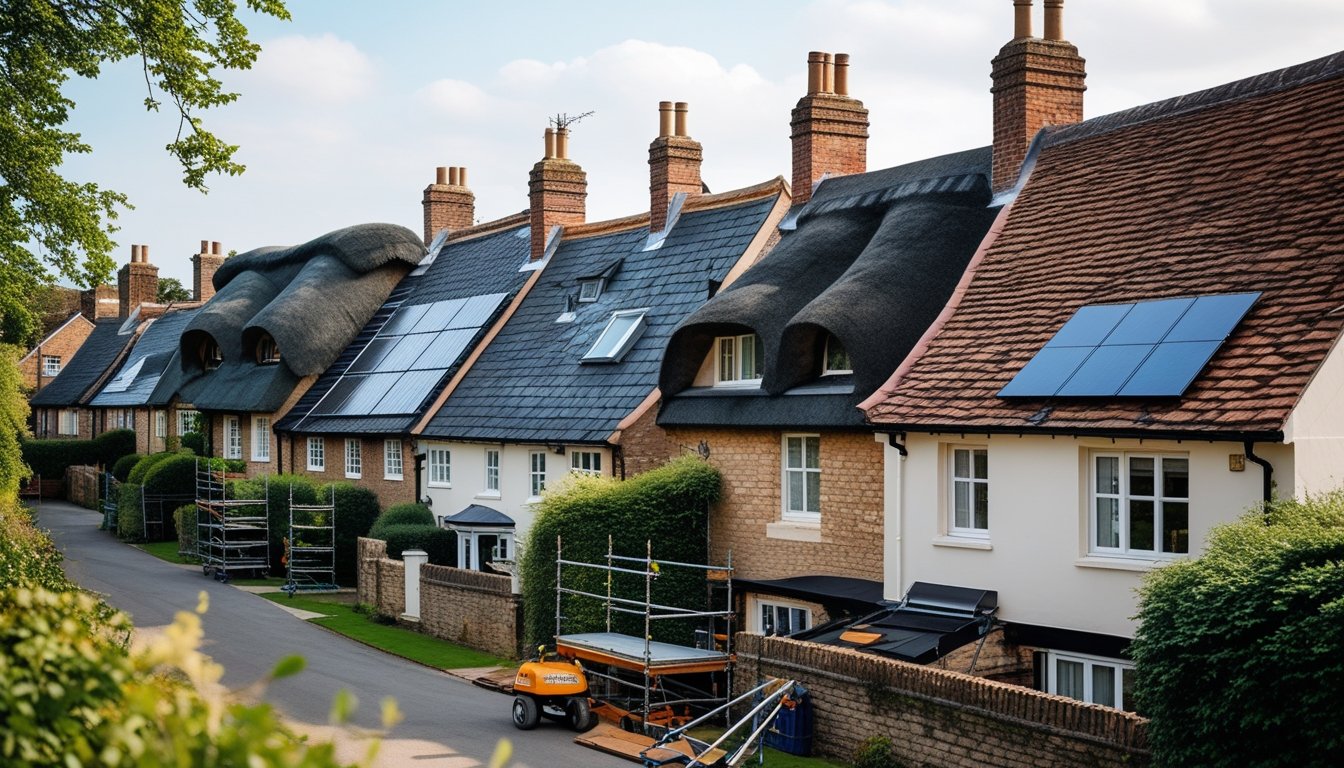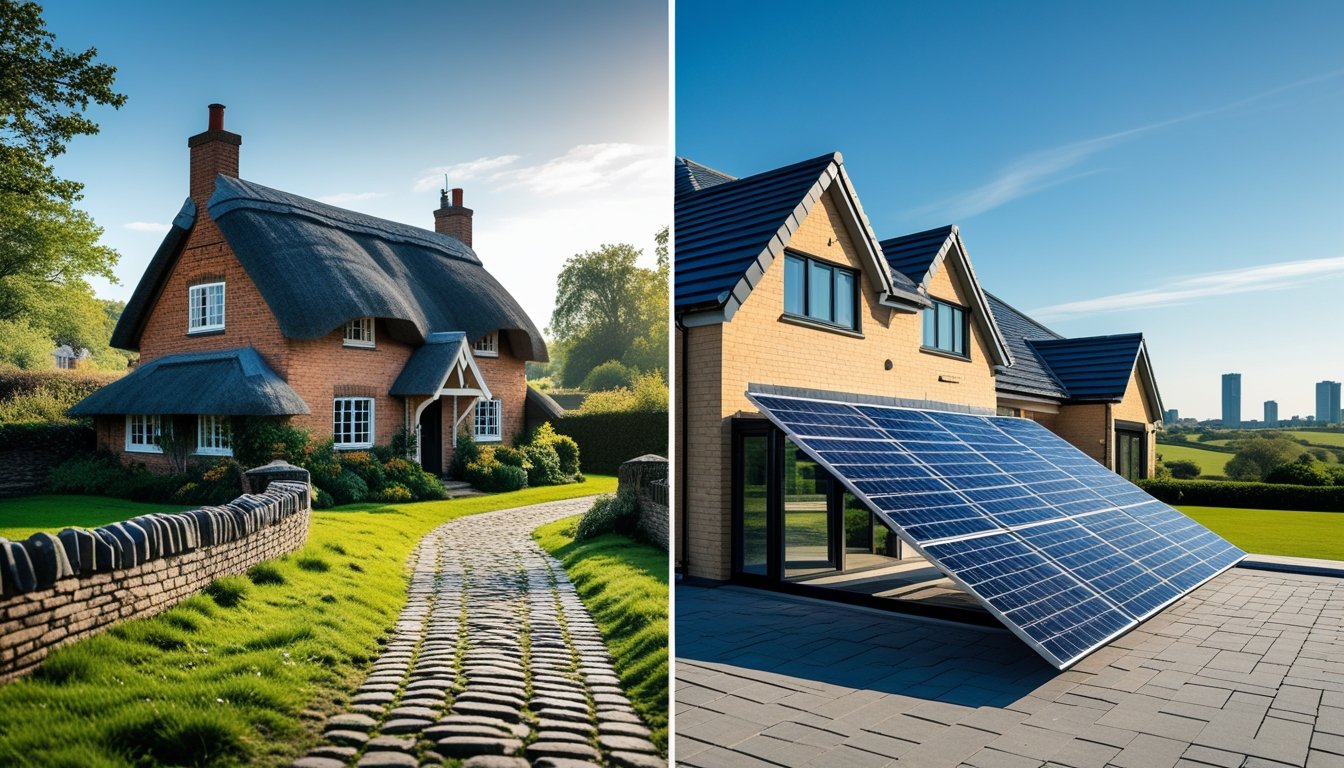Late updated: 26 May 2025 15:05
Written by: Oliver Bennett
Historical Evolution Of UK Roofing Practices: A Detailed Overview
Exploring the historical evolution of roofing practices in the UK reveals fascinating insights into our architectural past. From ancient Roman tiles to the rustic charm of thatched roofs, the materials and designs have both adapted and endured through centuries. Roofing in the UK has reflected societal needs and available resources, illustrating a blend of functionality and aesthetic appeal.

During the 17th to 19th centuries, roofing materials were often dictated by local availability and technological advancements. Wood, slate, and clay tiles dominated, addressing both the aesthetic and practical considerations of the time. The catastrophic Great Fire of London underscored the importance of fireproof materials, pushing forward innovations and changing preferences.
In our modern era, while we embrace innovations and efficiency, there's a conscious effort to preserve historical roofing techniques. This balance between progress and preservation allows us to maintain our architectural heritage while meeting contemporary standards.
Key Takeaways
- UK roofing practices show a diverse evolution of materials and designs.
- Historical events influenced the shift towards safer, more durable materials.
- Modern efforts balance innovation with conservation of historic roofs.
Early Roofing Practices and Materials
In Britain, early roofing methods evolved from using locally available materials, each chosen for its practicality and effectiveness. As we examine these early techniques, the focus will be on thatch, timber frames, stone slate, clay tiles, and Welsh slate, highlighting their unique properties and contributions to roofing history.
Thatch and Water Reed in Pre-industrial Britain
Thatch, made from straw or water reed, was a common roofing material due to its abundance and thermal efficiency. It provided excellent insulation, keeping buildings warm in winter and cool in summer. Water reeds, particularly durable, were favoured in many regions.
The thatching process involved layering the reeds to form a dense, watertight roof structure. This technique, prevalent before industrialisation, was both labour-intensive and skill-dependent. Thatched roofs were especially popular in rural areas where the materials were readily available. Despite their rustic charm, they required regular maintenance to extend their lifespan, often needing repairs every few decades, depending on weather exposure.
The Use of Timber Frames and Stone Slate
Timber frames played a crucial role in early roofing, providing the necessary support for various roofing materials. The combination of wood with stone slate made for a resilient roof structure. Stone slate, quarried from local sources, was a durable and fire-resistant choice.
The use of stone slate began to flourish in areas like the Cotswolds, where these resources were abundant. Roofs constructed from timber and slate not only offered durability but also aesthetic appeal. The individual slate tiles were cut to size and layered meticulously. We observed that while wooden frameworks required regular treatment to prevent decay, stone slate's longevity often surpassed other materials, making it a prized option in the UK.
Transition to Clay Tiles and Their Impact
Clay tiles marked a significant evolution in British roofing, introduced by the Romans around 100 AD. Their uniform shape and ability to interlock provided better rain resistance and ease of installation compared to earlier materials. Clay tiles, unlike thatch, were less flammable, adding a crucial safety feature to buildings.
The adoption of clay tiles was initially limited to wealthier classes due to their cost. As production techniques improved, they became more accessible. Their durability and broad colour range made them a preferred choice in many urban areas. Clay tiles’ introduction reduced the reliance on natural materials and paved the way for more sophisticated roofing methods.
Characteristics of Welsh Slate and Slates
Welsh slate emerged as a premier choice for roofing due to its exceptional density and durability. Quarried in Wales, it became famous for its unique blue-grey colour. The material's high quality made it resistant to harsh weather conditions, a critical factor for its widespread use.
Slate’s thin yet sturdy profile allowed it to be easily cut into uniform pieces. This precision enhanced the roof’s appearance and efficiency in water runoff. Welsh slate became an architectural staple, renowned for its longevity, often lasting over a century. Its widespread use significantly influenced roofing practices across Britain, leaving a lasting legacy in the architectural landscape.
Modern Influences and Conservation of Historic Roofs

The history of roofing in the UK shows a seamless blend between traditional craftsmanship and modern innovation. This section examines how the Industrial Revolution spurred innovations in roofing materials and the developments during the Victorian period. It discusses the impact of modern technology on durability, energy efficiency, and the importance of conservation efforts in preserving historic integrity.
The Industrial Revolution and Roofing Innovations
The Industrial Revolution significantly transformed roofing practices by introducing mass production techniques and new materials. For the first time, roofing materials could be produced and distributed efficiently, making them more accessible. Steam-powered machinery enabled large-scale production of roofing slate and clay tiles, which contributed to a dramatic change in construction practices.
Moreover, iron and steel began to appear in building design, offering robust support structures for roofs. The architectural identity evolved, with buildings featuring more complex and varied roof designs. These changes allowed for the rapid development of urban areas, supporting architectural growth while preserving the functionality and safety of historic buildings.
Concrete Tiles, Slate Industry, and Victorian Period Developments
The Victorian period marked significant advancements in roofing materials, notably with the founding of the concrete tile industry. Concrete tiles offered an affordable and durable alternative to slate and clay, heralding a new era of roofing options for historic restorations. The widespread availability of roofing slate was enhanced, facilitating a continuation of the elegant, traditional roofs prevalent in this time.
During this period, the design sophistication of roofs increased dramatically. Structures often featured intricate patterns and ornamental detailing. This era's architectural innovation ensured the aesthetic qualities of slate roofing while adhering to new building codes and standards, which played a crucial role in the heritage conservation efforts we see today.
Durability, Energy Efficiency, and Insulation of Roof Coverings
Modern influences have encouraged an emphasis on durability, energy efficiency, and insulation in roof coverings. New technology has brought advanced materials that enhance the longevity of roofs while providing better protection against the elements. For instance, improved insulation properties in roofing materials aid in energy conservation, reducing heating and cooling needs.
The focus on sustainability has only grown, with materials like synthetic slate now replicating traditional aesthetics but with enhanced energy efficiency. As we adapt these innovations to historic roofs, maintaining the architectural design without compromising modern standards is vital. This integration helps uphold the character of old buildings while improving their energy performance.
Conservation Efforts and Preservation of Architectural Identity
Conservation efforts work diligently to preserve the architectural identity of historic roofs. Heritage organisations and conservationists push for legislation that protects these structures, ensuring that renovations and repairs align with the original design intents. Attention to detail is paramount, particularly with regard to materials and techniques resembling traditional methods.
By advocating for sustainability, these efforts help us retain the charm and historical significance of these roofs. The preservation process involves meticulously planning to address issues like weathering and decay, ensuring that both the aesthetic and structural integrity of the roof are maintained. This dedication to conservation maintains our architectural legacy for future generations.
Frequently Asked Questions

Roofing practices in the UK have evolved significantly over the centuries, influenced by available materials, architectural trends, and technological advancements. From the traditional thatched roofs to the introduction of slate and the development of modern techniques, each era brought distinctive changes.
What materials have traditionally been used for roofing in the United Kingdom?
In the UK, traditional roofing materials included thatch, slate, and clay tiles. Thatched roofs were common in rural areas, utilising straw, reed, or rushes. Slate, valued for its durability and aesthetic appeal, later became popular, especially in regions where slate was naturally available. Clay tiles were also widely used.
How have roofing styles changed throughout different architectural periods in the UK?
Roofing styles in the UK have been influenced by various architectural periods. During the medieval era, thatched and clay-tiled roofs were prevalent. The Georgian and Victorian periods saw a shift towards slate and the more elaborate use of tiles. Modern architecture has expanded materials to include concrete tiles and metal.
What are the key historical developments that have influenced UK roofing techniques?
Key developments include the Roman introduction of slate tiles, advancements during the Industrial Revolution, and the post-war period's increased use of concrete tiles. Each period saw innovations that adapted roofing practices to new technologies and materials, enhancing durability and design.
When did slate roofing become prominent in British architecture, and why?
Slate became prominent in British architecture during the 19th century, largely due to the expansion of the railway network which facilitated its distribution. Its durability, fire resistance, and aesthetic qualities made it an attractive option, especially during the Victorian era, when decorative and enduring materials were highly sought after.
How were thatched roofs constructed and maintained historically in the UK?
Historically, thatched roofs were constructed using locally sourced reed, straw, or heather, layered thickly to provide insulation and waterproofing. Maintenance was crucial, with regular rethatching and repairs needed every 10 to 20 years to ensure longevity, typically carried out by skilled craftsmen.
What advancements in the 20th century had a significant impact on roofing practices in the UK?
The 20th century saw significant advancements, including the development of concrete roof tiles and synthetic materials that offered cost-effective and durable alternatives to traditional options. Additionally, improved waterproofing technologies and insulation techniques enhanced the functionality and efficiency of modern roofs.
